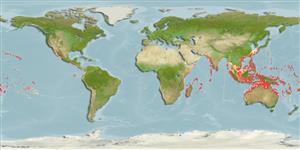Preferred temperature (Ref.
123201): 24.3 - 28.9, mean 27.6 °C (based on 1090 cells).
Phylogenetic diversity index (Ref.
82804): PD
50 = 0.5002 [Uniqueness, from 0.5 = low to 2.0 = high].
Bayesian length-weight: a=0.02399 (0.01377 - 0.04179), b=2.93 (2.78 - 3.08), in cm total length, based on LWR estimates for this species & (Sub)family-body (Ref.
93245).
Nivel trófico (Ref.
69278): 3.1 ±0.33 se; based on food items.
Resiliencia (Ref.
120179): Medio, población duplicada en un tiempo mínimo de 1.4-4.4 años (Preliminary K or Fecundity.).
Fishing Vulnerability (Ref.
59153): Low to moderate vulnerability (28 of 100).
Nutrients (Ref.
124155): Calcium = 24.5 [7.4, 74.5] mg/100g; Iron = 0.747 [0.264, 2.049] mg/100g; Protein = 18.1 [15.9, 20.3] %; Omega3 = 0.0791 [, ] g/100g; Selenium = 52.1 [19.6, 143.4] μg/100g; VitaminA = 52.1 [14.7, 187.9] μg/100g; Zinc = 1.59 [0.74, 2.80] mg/100g (wet weight);
